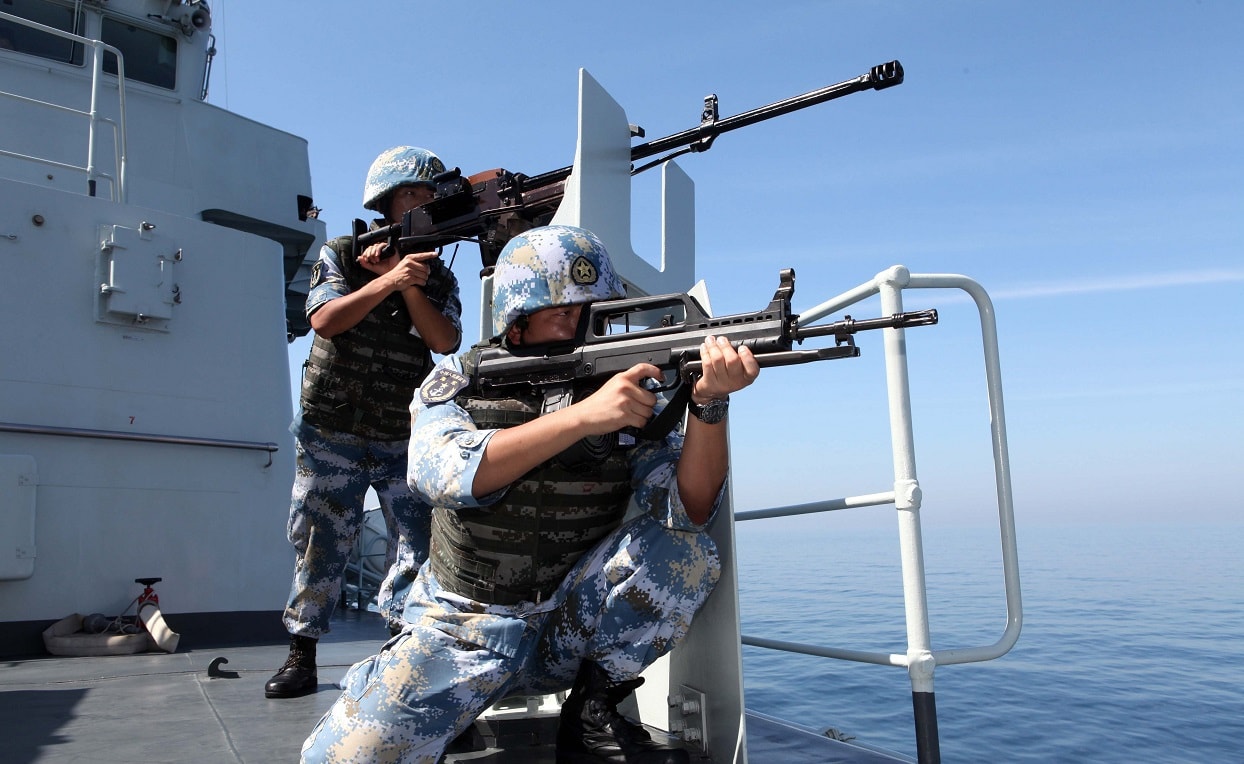China’s Marine Corps is becoming more like the U.S. Marine Corps, suggests a new Pentagon report.
Even as the U.S. Marine Corps is reshaping itself to become a more high-tech force capable of battling China in the Pacific, China’s People’s Liberation Army Navy-Marine Corps (PLANMC) is moving beyond local operations such as invading Taiwan. Instead, it is being configured for long-distance operations beyond China’s borders.
“The focus of the PLANMC appears to be shifting towards global expeditionary operations,” warned the Department of Defense’s 2021 annual report to Congress on Chinese military power.
“The PLANMC continues to make strides towards becoming a multidimensional expeditionary force capable of conducting operations beyond the First Island Chain [the South China and East China Seas] to protect the PRC’s growing overseas interests,” the report said. “The PLANMC has conducted a variety of cross-regional training exercises to improve long-range mobility and the ability to operate across diverse climates and terrain in pursuit of rapid reaction capabilities. Additionally, the PLANMC devotes time and resources to conducting NWMA [non-war military activities], to include counter-piracy operations and international military engagements.”
In its 2017 China report, the Pentagon predicted that China’s two brigades of marines – about 10,000 men – would expand to seven brigades and 30,000 men by 2020. That estimate proved slightly short: the PLANMC has eight brigades, including six maneuver brigades, a special brigade, and an aviation brigade. Chinese marines are receiving new equipment — including new Type 05 amphibious armored vehicles – and they will be transported by new Chinese Navy Type 075 amphibious assault ships that can carry a battalion of marines, plus helicopters and potentially vertical-takeoff jets.
Comparing the Chinese and U.S. Marine Corps is difficult. The U.S. Marine Corps is a unique force of nearly 200,000 personnel The U.S. Marine Corps is a unique organization: a nearly 200,000-strong force – with its own air force – that essentially a smaller, more mobile version of the U.S. Army, and is considered one of the six branches of the U.S. military. While ostensibly designed for expeditionary operations, the USMC has fought long-term ground campaigns, including Korea, Vietnam, and Afghanistan and Iraq.
In contrast, like most marine forces around the world, the PLANMC is naval infantry in the traditional sense: an adjunct to the navy, designed primarily for naval-related missions such as amphibious operations or securing naval bases. Given that China’s goals have been local – invading Taiwan, controlling Japanese-held islands in the East China Sea, etc. – the PLANMC could operate locally.
But China is assuming a more global role, including an African military base at Djibouti, which includes a PLANMC contingent. As U.S. Marines frequently do, Chinese marines have conducted training in desert, jungle and cold weather environments, and they have participated in joint exercises with multiple nations, and they have units deployed at sea. “The PLANMC’s presence in Djibouti provides the PRC with the ability to support a military response to contingencies affecting the PRC’s investments and infrastructure in the region and the approximately 1 million PRC citizens in Africa and 500,000 in the Middle East,” noted the Pentagon report. “The PLANMC also embarks a contingent of marines with the PLAN’s Gulf of Aden counterpiracy-focused naval escort task force that supports the PRC’s trade interests. Additionally, the PLANMC supports the PRC’s military diplomacy. For example, it has trained with Russian and Thai forces and participated in exchanges with the United States and Australia.”
The PLANMC has not met the Chinese government’s goal of fully “mechanizing” the Chinese military – which includes modernized weapons, Artificial Intelligence and networked systems – by 2021. However, “an additional PLANMC brigade likely reached fully mission capable status in 2020 while another four brigades likely achieved initial operating capability (IOC) status,” the report said. “One of the three brigades reaching IOC was the PLANMC’s aviation brigade, which graduated its first group of domestically trained ship-borne pilots in April 2020. This growing multifaceted aviation brigade provides the PLAN and PLANMC with an increasingly proficient quick reaction capability.”
Ironically, the U.S Marine Corps appears to be changing. Gen. David Berger, the Marine Corps Commandant, wants to transform the USMC from a force of riflemen with low technical skills and high personnel turnover, to an organization of technically skilled, long-term professionals. The Marines are disbanding their tank battalions, but they’re also creating teams armed with anti-ship missiles that can defend Pacific islands and pick off Chinese warships.
It’s hard to imagine the Chinese Marine Corps becoming an identical twin of the U.S. Marine Corps. The U.S. Marines are as much a cultural icon – like the photos of Marines raising the American flag on Iwo Jima – as a military force. And for the U.S., which has taken care to ensure that its wars are fought overseas rather than on American territory, having a large combat force designed for expeditionary warfare can be an asset.
While Chinese security interests are becoming more global – if only to protect the trade routes and natural resources that sustain its economy – China still seems focused on local objectives near its land and maritime borders. But if Beijing casts its gaze further from China’s shores, the Chinese Marine Corps may be a key instrument for achieving that vision.
Michael Peck is a frequent 1945 Contributing Writer and defense journalist based in Oregon. His work has appeared in many outlets like Forbes, National Interest, The Drive: Warzone and many others.

